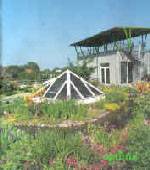When used in reference to fertilizers, the word organic
generally means that the nutrients contained in the product are derived solely
from the remains or a by-product of an organism. Cottonseed meal, blood meal,
fish emulsion, manure and sewage sludge are examples of organic fertilizers.
Urea is a synthetic organic fertilizer, an organic substance manufactured from
inorganic materials.
When packaged as fertilizers, organic products have the
fertilizer ratio stated on the package label. Some organic materials,
particularly composted manures and sludges, are sold as soil conditioners and do
not have a nutrient guarantee stated on the package, although small amounts of
nutrients are present.
Some organic fertilizers are high in one of the three major
nutrients (nitrogen, phosphorus, or potash,) but low or zero in the other two.
Some are low in all three macronutrients. A few organic products can be
purchased "fortified" for a higher nutrient analysis. The ingredients
used to fortify organic fertilizers are organic materials; for example, rock
phosphate to increase phosphorus, or greensand to increase potash.
Organic fertilizers depend on soil organisms to break them
down to release nutrients; therefore, most are effective only when soil is moist
and warm enough for the microorganisms to be active. Nutrient release by
microbial activity, in general, occurs over a fairly long time period. One
potential drawback is that the organic fertilizer may not release enough of
their principal nutrient when the plant needs it for growth.
Cottonseed meal is a by-product of cotton manufacturing. As a
fertilizer, it produces a somewhat acidic reaction; consequently, it is
frequently used for fertilizing acid-loving plants such as azaleas, camellias,
and rhododendrons. Formulas vary slightly, but generally, cottonseed meal
contains 7 percent nitrogen, 3 percent phosphorus, and 2 percent potash.
Nutrients are most readily available to plants in warm soils, but there is
little danger of burn.
Blood meal is dried, powdered blood collected from cattle
slaughterhouses. It is a rich source of nitrogen, so rich, in fact, that it may
burn plants if used in excess. Gardeners must be careful not to exceed the
recommended amount suggested on the label. In addition to nitrogen, blood meal
supplies some essential trace elements, including iron.
Fish emulsion, a balanced, organic fertilizer, is a partially
decomposed blend of finely pulverized fish. A strong odor is associated with
most brands of fish emulsion fertilizer, but the smell dissipates within a day
or two. Recently, deodorized brands have been developed.
Fish emulsion is high in nitrogen and is a source of several
trace elements. Contrary to popular belief, too strong a solution can burn
plants, particularly those growing in containers. In the late spring, when
garden plants have sprouted, an application of fish emulsion followed by a deep
watering will boost the plants' early growth spurt.
Manure is a complete fertilizer, but low in the amount of
nutrients it supplies. Manures vary in nutrient content according to the animal
source and what the animal has been eating. A fertilizer ratio of 1-1-1 is
typical. Commonly available manures include horse, cow, pig, chicken and sheep.
The highest nutritional concentration is found in manure when
it is fresh. As it is aged, exposed to weather, or composted, nutrient content
is reduced. However, most gardeners prefer to use composted forms of manure to
ensure lesser amounts of salts, thereby reducing the chance of burning plant
roots. Because of its low concentration of plant nutrients, manure is best used
as a soil conditioner instead of a fertilizer. Typical rates of manure
applications vary from a moderate 70 pounds per 1000 square feet to as much as
one ton per 1000 square feet.
Sewer sludge is a recycled product of municipal sewage
treatment plants. Two forms are commonly available: activated and composted.
Activated sludge has higher concentrations of nutrients (approximately 6-3-0)
than composted sludge. It is usually sold in a dry, granular form for use as a
general purpose, longlasting, nonburning fertilizer. Composted sludge is used
primarily as a soil amendment and has a lower nutrient content (approximately
1-2-0).
There is some question about the long term effects of using
sewage sludge products in the garden, particularly around edible crops. Heavy
metals such as cadmium, sometimes present in the sludge, may build up in the
soil. Possible negative effects vary with the origin of the sludge and with the
characteristics of the soil where it is used.
Compared to synthetic fertilizer formulations,organic
fertilizers contain relatively low concentrations of actual nutrients, but they
perform important functions which the synthetic formulations do not. They
increase the organic content and consequently the water-holding capacity of the
soil. They improve the physical structure of the soil which allows more air to
get to plant roots. Where organic sources are used for fertilizer, bacterial and
fungal activity increases in the soil. Mycorrhizal fungi which make other
nutrients more available to plants thrive in soil where the organic matter
content is high. Organically derived plant nutrients are slow to leach from the
soil making them less likely to contribute to water pollution than synthetic
fertilizers.
![]() Gardeners' Corner
Kids'
Garden
Sustainable Garden
Contact Us
Gardeners' Corner
Kids'
Garden
Sustainable Garden
Contact Us![]()


